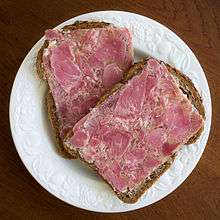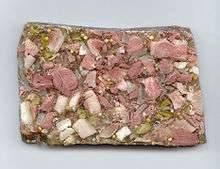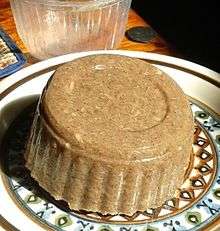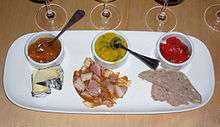Head cheese


Head cheese or brawn is a cold cut that originated in Europe. A version pickled with vinegar is known as souse. Head cheese is not a dairy cheese, but a terrine or meat jelly made with flesh from the head of a calf or pig, or less commonly a sheep or cow, and often set in aspic. The parts of the head used vary, but the brain, eyes, and ears are usually removed. The tongue, and sometimes the feet and heart, may be included. It can also be made from quality trimmings from pork and veal, adding gelatin to the stock as a binder.
Head cheese may be flavored with onion, black pepper, allspice, bay leaf, salt, and vinegar. It is usually eaten cold or at room temperature.
Historically, meat jellies were made of the cleaned (all organs removed) head of the animal, which was simmered to produce stock, a peasant food made since the Middle Ages. When cooled, the stock congeals because of the natural gelatin found in the skull. The aspic may need additional gelatin, or more often, reduction to set properly.
Terminology
The term 'head cheese' is used in North America,[1][2][3] 'potted heid' in Scotland,[4][5] 'brawn' elsewhere in Britain[4][6][7][8][9][10] and Australia.[11] The term 'souse' for the pickled variety is North American and West Indian.[12]
By country
Europe

- Austria
- In Austria, head cheese is known as Presswurst, Sulz or Schwartamaga in the most western regions. Depending on the region, it's often served with a light dressing (vinegar, sunflower seed oil or pumpkin seed oil, sliced onions).
- Bulgaria
- In Bulgaria, the meal пача (pacha) is prepared from pig's heads (primarily the ears), legs, and often tongue. The broth is heavily seasoned with garlic before cooling.
- Croatia
- This cut is generally known as hladetina, and is commonly produced after the traditional slaughter of pigs. A strongly seasoned version of this cut is called tlačenica or švargla (the latter being a loan-word from German). The name švargl is used for a variant where the chopped parts are stuffed inside the pig's stomach, similar to Scottish haggis.
- Cyprus
- in Cyprus it is made with pork and known as zalatina, a word probably derived from the English word gelatin. It is often seasoned with lemon juice.
- Czech Republic
- In the Czech Republic, the huspenina or sulc (from German Sülze) is made from pig's heads and/or legs boiled together, chopped, mixed into their own broth, poured into a pan, and left in the cold to solidify. Other ingredients include onion, pepper, allspice, bayleaf, vinegar, salt, carrot, parsley, root celery, and sometimes eggs. A similar product, tlačenka, is basically huspenina with some more meat, chopped liver, and various offal, poured into a prepared pig stomach and left to solidify under the weight. Tlačenka is generally thicker than huspenina, and it is commonly eaten with chopped onions and sprinkled with vinegar.
- Denmark, Norway, and Sweden
- Sylte, sylta or aladåb, was originally made from head of pig, but is now commonly made from the forequarters or shanks of pork or veal and seasoned with allspice, bay leaves, and thyme, and forms part of the traditional Christmas smörgåsbord, served on rugbrød or lefse with strong mustard and pickled beetroots. A rolled version (Danish/Norwegian: rullepølse, Swedish: rullsylta) made in an otherwise similar way also exists, however this contains only very little aspic.
- Estonia
- Sült is similar to the German or Croatian dish (the name is a loan, as well), but is usually less seasoned and is made from higher quality meat. Sometimes carrots or greens are added. It is a traditional Christmas dish, but is sold in stores year round. The traditional sült is made from pork using its gelatinous parts. Beef, poultry, and fish variants also are available.
- Finland
- In Finland, head cheese is known as syltty, tytinä or aladobi.
- France
- In French, it is referred to as fromage de tête, tête pressée, tête fromagée (which translates as "cheesed head") or pâté de tête.

- Germany
- In Germany, head cheese is known as Sülze, Schwartenmagen, or Presskopf. In Bavaria, Presssack comes in three varieties (deep red, pinkish, and grey) in the form of a large (15-cm-diameter) sausage. Sülze can have a tangy flavour due to the addition of pickles or vinegar. It usually takes the form of a rectangular loaf, which is then sliced into portions. There is a white coloured variety and two different red ones, using blood, one made with beef tongue (as in Zungenwurst) and aspic, the other without. In Franconia, Saurer Presssack is served in a salad with a vinaigrette and vegetables.

- Early references to Sulcze in documents of the Counts of Katzenelnbogen date from 1410 and 1430.[13]
- Greece
- In Greece and among Greeks of the diaspora, it is known as pichti "πηχτή".
- Hungary
- A variant of head cheese, disznósajt, or disznófősajt (pork cheese or pork head cheese), is made of mixed meat slices (especially from the head of the pig,[14]) spices, paprika, and pieces of bacon cooked in spicy stock. The chopped meat is stuffed into the pig's stomach, similarly to Scottish haggis, pricked with needles, then pressed down with weights to remove excess fat and make it tight and compact. Often it is smoked like sausages or ham.
- Iceland
- Sviðasulta a form of head cheese, is made from svið, singed sheep's head, sometimes cured in lactic acid.
- Italy
- In Genoa, a similar cold cut goes by the name of testa in cassetta, literally "head in a box", but it is possible to find it throughout the entire central and northern Italy, where it is called coppa di testa, or simply coppa, soppressata in Tuscany, or – in some northern regions – formaggio di testa (head cheese). In central Italy (Lazio, Umbria), it is common to put orange peel pieces in it, or to serve it in a salad together with oranges and black olives.
- Latvia
- Galerts is similar Latvian food consisting from meat in gelatin, often with vegetables, such as carrots, and celery added to the resulting colloidal suspension. Horseradish and/or vinegar can be poured over the galerts when serving it.
- Lithuania
- Košeliena (deriving from košė (pulp or squash) or šaltiena (deriving from šalta, "cold", and refers to way of serving the dish), is usually made from pig's feet; sometimes part of head is added.
- Netherlands and Belgium
- Headcheese is known under several regional names and variations. In Brabant, it is called zult and is made with blood. Pig's foot provides the gelatin and a little vinegar is added to it. In Limburg, it is called hoofdkaas, meaning head cheese, and is eaten on bread or with Limburgisch sausage as a starter. A red, sweet variety and a slightly sour, grey variety are available. The red one can be compared to Brabantic zult. Both zult and preskop are also found in Limburg, though zult is less sour, whereas preskop often contains black pepper and is eaten on wholewheat bread. In Belgium, head cheese is also called kop or kopvlees, which translates as "meat from the head".
- Poland
- In Poland, head cheese is referred to as salceson, a name possibly derived from saucisson, the French word for a type of sausage. The several varieties of salceson depend on the ingredients; black salceson contains blood, white salceson is made with a mixture of seasoned meats without blood, and ozorkowy (tongue) salceson uses tongue as the major meat component.
- Portugal
- In Portugal, this delicacy, known as cabeça de xara, is mainly prepared in the Alentejo region.[15]
- Romania
- The two versions of it are tobă (drum) or, especially in Transylvania, caş de cap de porc (pig head cheese, akin to the Hungarian disznófősajt), which looks like a wide sausage, 4-in-diameter, and the marginally similar piftie. This is the same dish as Serbian and Macedonian pihtije), in which the contents are poured into a bowl and refrigerated. Piftie is not necessarily head meat, but can be different kinds of meat, boiled with garlic and bay leaves. It is prepared by boiling pig's feet to make a soup, because they contain more gelatin than any other part of the pig. The mixture is then cooled to make a jelly. Usually, garlic is added.
- Russia and Ukraine
- In Russia and Ukraine, head cheese is a popular food for festive occasions. In Ukraine, it is called kovbyk (ковбик). Beef or lamb head cheese is also popular in the Jewish community. It is more popularly called saltisón (салтисон) or kholodets (холодец).
- Slovakia
- A special variety of head cheese, called tlačenka (pressed one), is very popular in Slovakia. It is made of pork stomach stuffed with offal and leftover parts of pig's heads and legs. It is seasoned with garlic, paprika, black pepper, and other ingredients and usually smoked. It is traditionally served with sliced onion, vinegar, and bread.
- Huspenina (also called studeno, meaning "cold one") is similar to a certain extent, but made with less meat and more gelatine. It is more similar to aspic, pork jelly, or hladetina.
- Slovenia
- In Slovenia, it is known as tlačenka, "pressed-one", or informally as žolca.

- Spain
- This cold cut is known as cabeza de jabali, "boar's head".
- Sweden
- Known as sylta, a few variations are available with different meats, spices, and preparation methods, the most popular being kalvsylta (veal brawn), pressylta (pressed pork and veal brawn), and rullsylta (rolled and pressed side of pork). Common seasonings are onions, white pepper, allspice, cloves, salt and bay leaves, and occasionally carrots and herbs are added to the ingredients. Sylta is often regarded as a seasonal food eaten at the julbord at Christmas.
- United Kingdom
- In England and Wales, head cheese is referred to as brawn or (in Yorkshire and Norfolk) pork cheese. In Scotland, it is known as potted heid (potted head of beef, pork, or sheep); the similar potted haugh or hough is made from the shank of the animal.
Asia
- China
- In certain parts of Northern China, such as Beijing, 'pig head meat' is cooked and thinly sliced and served at room temperature. In another Northern city: Tianjin, yaorou (肴肉) is made by boning and pickling pig trotters with brine and alum. The meat is then rolled, pressed and eaten cold.[16] In northeastern China, a jellied pork skin dish is often made and served with a spicy soy sauce and vinegar mixture with crushed garlic and red chili powder.[17]
- Korea
- In Korean cuisine, a similar dish, pyeonyuk (편육), is made by pressing meat, usually from the head of the pig. It is eaten as anju (dishes associated with alcoholic beverages) or used for janchi (잔치, for feast or banquet).
- Vietnam
- In Vietnam around Tết, giò thủ is made in celebration for the New Year. It is a traditional snack made of fresh pork belly, pig’s ears, garlic, scallions, onions, black fungus, fish sauce, and cracked black pepper. Traditionally, giò thủ (pork head meat pie) is wrapped in banana leaves and compressed in a wooden mold until the gelatin in the pig’s ears causes it to stick together.
Australia
In Australia, it is known as brawn or Presswurst. It is usually seen as something of an old-fashioned dish, although various large firms, such as Don Smallgoods and KR Castlemaine produce it.
Caribbean
Souse is pickled meat and trimmings usually made from pig's feet, chicken feet or cow's tongue, to name a few.[18] The cooked meat or trimmings are cut into bite-sized pieces and soaked in a brine made of water, lime juice, cucumbers, hot pepper, salt and specially prepared seasonings. It is usually eaten on Saturday mornings, especially in St. Vincent and Barbados. In Trinidad and Tobago, it is served or sold at most social gatherings, such as parties, all-inclusive fetes and sporting competitions.
Latin America
Head cheese is very popular and is usually referred to as queso de cabeza in Chile and Colombia. In Peru, Ecuador, and Costa Rica, it is also known as queso de chancho. It is known as queso de Cerdo in Uruguay and Argentina. In Panama, it is known as sao (from Caribbean English souse), made with pig's feet and prepared the same way as in the Caribbean; it is a dish from the Caribbean coast, where most of Panama's West Indian community lives.
- Brazil
- In Brazil, head cheese is very popular among the gaucho population and is commonly known as queijo de porco (pig cheese). In the German-colonized cities, such as Pomerode and Blumenau, it follows the German recipe and is known as Sülze.
- Mexico
- In Mexico, it is known as queso de puerco and is usually spiced with oregano, vinegar, garlic, and black pepper.[19]
North America
- Alberta
- the typical jellied meat available in stores is labelled "head cheese", whether or not it is actually made from the head. The large Eastern European community in the province also has a (declining) tradition of making jellied meat at home, usually from pigs' feet, and this is called sutedentz in the local dialect of the Ukrainian language.
- Pennsylvania, United States
- In the Pennsylvania Dutch dialect, head cheese is called souse. Pennsylvania Germans usually prepare it from the meat of pig's feet or tongue and it is pickled with sausage.
- Louisiana, Mississippi, and other portions of the Deep South, United States
- The highly seasoned hog's head cheese is very popular as a cold cut or appetizer. A pig's foot provides the gelatin that sets the cheese, and vinegar is typically added to give a sour taste. It is a popular Cajun food and is often encountered seasoned with green onions. In Mississippi, Alabama, and other southern states, it is encountered in a spicy form known as souse or less spicy hog's head cheese.
- Newfoundland and Labrador
- Throughout Newfoundland, brawn is typically made from wild game such as moose and caribou.
- Ontario
- Commercial, processed versions made with pork are sold in the deli section in some grocery stores in Ontario, such as in the German 'heimat' of Waterloo Region.
- Quebec
- Called tête fromagée, it is commonly available in grocery stores and butcher shops along with cretons and terrines.
- Prince Edward Island
- Now uncommon and seen as old fashioned. It was common before 1970 and often referred to as Potted head or Potted meat.
- New Brunswick
- A spread similar to cretons made from pork head and Boston Butt and seasoned primarily with onion, salt, and summer savory, is often referred to as head cheese.
See also
| Wikimedia Commons has media related to Head cheese. |
References
- ↑ "headcheese noun - definition in British English Dictionary & Thesaurus - Cambridge Dictionary Online". Dictionary.cambridge.org. 2013-06-11. Retrieved 2013-06-23.
- ↑ "Definition of headcheese". Collins English Dictionary. Retrieved 2013-06-23.
- ↑ "headcheese: definition of headcheese in Oxford dictionary (British & World English)". Oxforddictionaries.com. 2013-06-19. Retrieved 2013-06-23.
- 1 2 McNeill, F. Marian (1929). The Scots Kitchen (2006 ed.). Edinburgh: Mercat Press. p. 139. ISBN 1 84183 070 4.
potted head (or Scots brawn)
- ↑ Robinson, Mairi (1985). The Concise Scots Dictionary. Aberdeen University Press. p. 512. ISBN 0-08-028492-2.
- ↑ "Search Chambers - Free English Dictionary". Chambers.co.uk. Retrieved 2013-06-23.
- ↑ "Definition of brawn". Collins English Dictionary. Retrieved 2013-06-23.
- ↑ "brawn - Definition from Longman English Dictionary Online". Ldoceonline.com. Retrieved 2013-06-23.
- ↑ "brawn: definition of brawn in Oxford dictionary (British & World English)". Oxforddictionaries.com. 2013-06-19. Retrieved 2013-06-23.
- ↑ "Brawn - Definition and More from the Free Merriam-Webster Dictionary". Merriam-webster.com. 2012-08-31. Retrieved 2013-06-23.
- ↑ The Macquarie Dictionary and Thesaurus. Macquarie Uni., NSW 2109, Australia: Herron. 1991. p. 55. ISBN 0 949757 59 4.
- ↑ "souse: definition of souse in Oxford dictionary (British & World English)". Oxforddictionaries.com. 2013-06-19. Retrieved 2013-06-23.
- ↑ http://www.graf-von-katzenelnbogen.de/ 600 Years of Bratwurst, Head Cheese and the First Riesling of the World in Katzenelnbogen
- ↑ June Meyers Authentic Hungarian Heirloom Recipes Cookbook
- ↑ Outras Comidas. "Cabeça de Xara, Receita Cabeça de Xara". Pt.petitchef.com. Retrieved 2013-06-01.
- ↑ 断桥冬雪 (January 25, 2006). "记忆里的镇江肴肉(图)" (in Chinese).
- ↑ Archived January 9, 2009, at the Wayback Machine.
- ↑ Sinful alterations ruin boxed chocolates [Ontario Edition] March 27, 2002 page D.04 Toronto Star
- ↑ The People's Guide to Mexico By Carl Franz, Carl Franz, Lorena Havens, Steve Rogers, Lorena Havens
